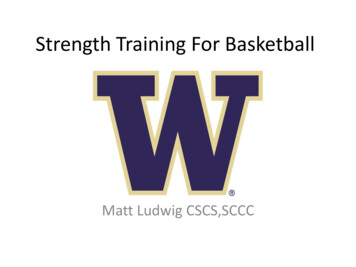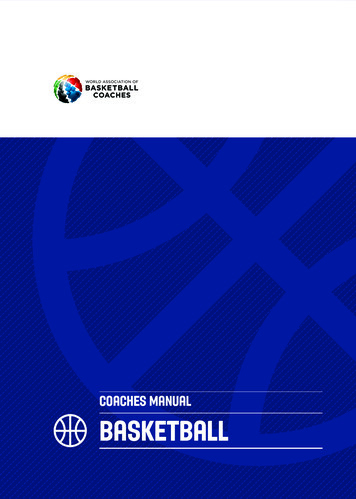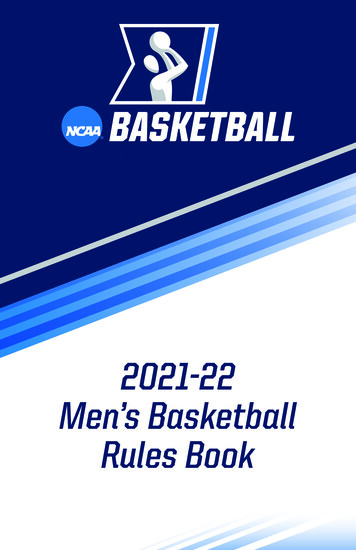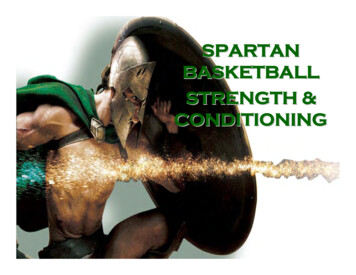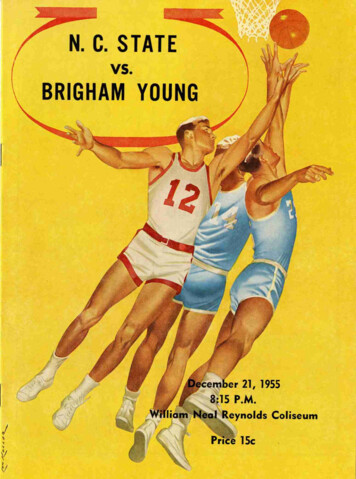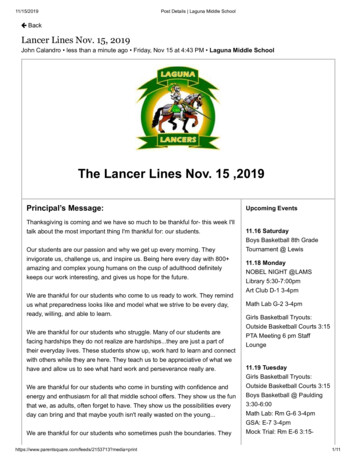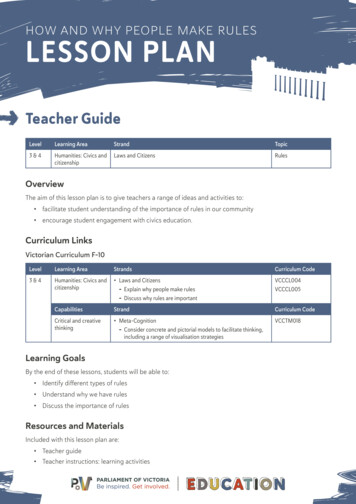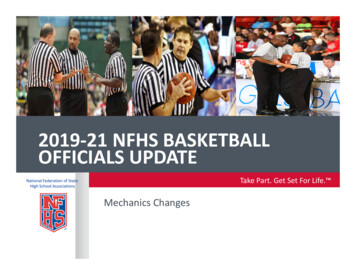
Transcription
2020OFFICIALBASKETBALLRULESBASKETBALL RULESworking version withyellow trackingValid as of 1st October 2020
Official Basketball Rules 2020As approved byFIBA Central BoardMies, Switzerland, 27th March 2020Valid as of 1st October 2020
Page 2 of 96OFFICIAL BASKETBALL RULES 2020June 2020
TABLE OF CONTENTSTABLE OF CONTENTS . 3TABLE OF DIAGRAMS . 4RULE ONE – THE GAME . 5Art. 1Definitions . 5RULE TWO – PLAYING COURT AND EQUIPMENT . 6Art. 2Art. 3Playing court. 6Equipment . 11RULE THREE – TEAMS . 12Art. 4Art. 5Art. 6Art. 7Teams . 12Players: Injury and assistance . 15Captain: Duties and powers. 15Head coach and first assistant coach: Duties and powers . 15RULE FOUR – PLAYING REGULATIONS . 17Art. 8Art. 9Art. 10Art. 11Art. 12Art. 13Art. 14Art. 15Art. 16Art. 17Art. 18Art. 19Art. 20Art. 21Playing time, tied score and overtime . 17Beginning and end of a quarter, overtime or the game. 17Status of the ball . 18Location of a player and a referee . 19Jump ball and alternating possession . 19How the ball is played . 21Control of the ball . 21Player in the act of shooting . 21Goal: When made and its value . 22Throw-in . 23Time-out . 24Substitution . 26Game lost by forfeit . 27Game lost by default . 28RULE FIVE – VIOLATIONS . 29Art. 22Art. 23Art. 24Art. 25Art. 26Art. 27Art. 28Art. 29Art. 30Art. 31Violations. 29Player out-of-bounds and ball out-of-bounds . 29Dribbling . 29Travelling . 303 seconds . 31Closely guarded player . 318 seconds . 3124 seconds . 32Ball returned to the backcourt . 34Goaltending and Interference . 35RULE SIX – FOULS . 37Art. 32Art. 33Art. 34June 2020Fouls . 37Contact: General principles . 37Personal foul. 43OFFICIAL BASKETBALL RULES 2020Page 3 of 96
Art. 35Art. 36Art. 37Art. 38Art. 39Double foul . 43Technical foul . 44Unsportsmanlike foul . 45Disqualifying foul . 46Fighting . 48RULE SEVEN – GENERAL PROVISIONS . 49Art. 40Art. 41Art. 42Art. 43Art. 445 fouls by a player . 49Team fouls: Penalty . 49Special situations . 49Free throws . 50Correctable errors . 52RULE EIGHT – REFEREES, TABLE OFFICIALS, COMMISSIONER: DUTIES AND POWERS . 54Art. 45Art. 46Art. 47Art. 48Art. 49Art. 50Referees, table officials and commissioner . 54Crew chief: Duties and powers . 54Referees: Duties and powers . 55Scorer and assistant scorer: Duties . 56Timer: Duties. 57Shot clock operator: Duties . 58A – REFEREES’ SIGNALS . 60B – THE SCORESHEET . 68C – PROTEST PROCEDURE . 77D – CLASSIFICATION OF TEAMS . 78E – MEDIA TIME-OUTS . 86F – INSTANT REPLAY SYSTEM . 87INDEX TO THE RULES . 89TABLE OF DIAGRAMSDiagram 1Diagram 2Diagram 3Diagram 4Diagram 5Diagram 6Diagram 7Diagram 8Diagram 9Diagram 10Diagram 11Diagram 12Diagram 13Diagram 14Page 4 of 96Full size playing court . 7Restricted area . 92-point/3-point field goal area . 9Scorer's table and substitution chairs . 10Cylinder principle . 38Players' positions during free throws . 51Referees' signals . 67Scoresheet . 68Top of the scoresheet . 69Teams on the scoresheet (before the game). 70Teams on the scoresheet (after the game) . 71Running score. 75Summing up . 76Bottom of the scoresheet . 76OFFICIAL BASKETBALL RULES 2020June 2020
Throughout the Official Basketball Rules, all references made to a player, coach, referee, etc.in the male gender also apply to the female gender. It must be understood that this is done forpractical reasons only.RULE ONE – THE GAMEArt. 1Definitions1.1Basketball gameBasketball is played by 2 teams of 5 players each. The aim of each team is to score inthe opponents' basket and to prevent the other team from scoring.The game is controlled by the referees, table officials and a commissioner, if present.1.2Basket: opponents'/ownThe basket that is attacked by a team is the opponents' basket and the basket whichis defended by a team is its own basket.1.3Winner of a gameThe team that has scored the greater number of game points at the end of playingtime shall be the winner.June 2020OFFICIAL BASKETBALL RULES 2020Page 5 of 96
RULE TWO – PLAYING COURT AND EQUIPMENTArt. 2Playing court2.1Playing courtThe playing court shall have a flat, hard surface free from obstructions (Diagram 1)with dimensions of 28 m in length by 15 m in width measured from the inner edge ofthe boundary line.2.2BackcourtA team's backcourt consists of its team's own basket, the inbounds part of thebackboard and that part of the playing court limited by the endline behind its ownbasket, the sidelines and the centre line.2.3FrontcourtA team's frontcourt consists of the opponents' basket, the inbounds part of thebackboard and that part of the playing court limited by the endline behind theopponents' basket, the sidelines and the inner edge of the centre line nearest to theopponents' basket.2.4LinesAll lines shall be of the same colour and drawn in white or other contrasting colour,5 cm in width and clearly visible.2.4.1Boundary lineThe playing court shall be limited by the boundary line, consisting of the endlines andthe sidelines. These lines are not part of the playing court.Any obstruction including seated head coach, first assistant coach, substitutes,excluded players and accompanying delegation members shall be at least 2 m fromthe playing court.2.4.2Centre line, centre circle and free-throw semi-circlesThe centre line shall be marked parallel to the endlines from the mid-point of thesidelines. It shall extend 0.15 m beyond each sideline. The centre line is part of thebackcourt.The centre circle shall be marked in the centre of the playing court and have a radiusof 1.80 m measured to the outer edge of the circumference.The free-throw semi-circles shall be marked on the playing court with a radius of1.80 m measured to the outer edge of the circumference and with their centres at themid-point of the free-throw lines (Diagram 2).Page 6 of 96OFFICIAL BASKETBALL RULES 2020June 2020
Diagram 1June 2020Full size playing courtOFFICIAL BASKETBALL RULES 2020Page 7 of 96
2.4.3Free-throw lines, restricted areas and free-throw rebound placesThe free-throw line shall be drawn parallel to each endline. It shall have its furthestedge 5.80 m from the inner edge of the endline and shall be 3.60 m long. Its mid-pointshall lie on the imaginary line joining the mid-point of the 2 endlines.The restricted areas shall be the rectangular areas marked on the playing courtlimited by the endlines, the extended free-throw lines and the lines which originate atthe endlines, their outer edges being 2.45 m from the mid-point of the endlines andterminating at the outer edge of the extended free-throw lines. These lines, excludingthe endlines, are part of the restricted area.Free-throw rebound places along the restricted areas, reserved for players duringfree throws, shall be marked as in Diagram 2.2.4.43-point field goal areaThe team's 3-point field goal area (Diagram 1 and Diagram 3) shall be the entire floorarea of the playing court, except for the area near the opponents' basket, limited byand including: The 2 parallel lines extending from and perpendicular to the endline, with theouter edge 0.90 m from the inner edge of the sidelines. An arc of radius 6.75 m measured from the point on the floor beneath the exactcentre of the opponents' basket to the outer edge of the arc. The distance of thepoint on the floor from the inner edge of the mid-point of the endline is 1.575 m.The arc is joined to the parallel lines.The 3-point line is not part of the 3-point field goal area.2.4.5Team bench areasThe team bench areas shall be marked outside the playing court limited by 2 lines asin Diagram 1.There must be 16 seats available in each team bench area for the head coach, theassistant coaches, the substitutes, the excluded players and the accompanyingdelegation members. Any other persons shall be at least 2 m behind the team bench.2.4.6Throw-in linesThe 2 lines of 0.15 m in length shall be marked outside the playing court at the sidelineopposite the scorer’s table, with the outer edge of the lines 8.325 m from the inneredge of the nearest endline.2.4.7No-charge semi-circle areasThe no-charge semi-circle areas shall be marked on the playing court, limited by: A semi-circle with the radius of 1.25 m measured from the point on the floorbeneath the exact centre of the basket to the inner edge of the semi-circle. Thesemi-circle is joined to: The 2 parallel lines perpendicular to the endline, the inner edge 1.25 m from thepoint on the floor beneath the exact centre of the basket, 0.375 m in length andending 1.20 m from the inner edge of the endline.Page 8 of 96OFFICIAL BASKETBALL RULES 2020June 2020
The no-charge semi-circle areas are completed by imaginary lines joining the endsof the parallel lines directly below the front edges of the backboards.The no-charge semi-circle lines are part of the no-charge semi-circle areas.Diagram 2Diagram 3June 2020Restricted area2-point/3-point field goal areaOFFICIAL BASKETBALL RULES 2020Page 9 of 96
2.5Position of the scorer's table and substitution chairs (Diagram 4)The scorer's table and its chairs must be placed on a platform. The announcer and/orstatisticians (if present) can be seated at the side of and/or behind the scorer’s table.Diagram 4Page 10 of 96Scorer's table and substitution chairsOFFICIAL BASKETBALL RULES 2020June 2020
Art. 3EquipmentThe following equipment shall be required: Backstop units, consisting of: Backboards Baskets comprising (pressure release) rings and nets Backboard support structures including padding. Basketballs Game clock Scoreboard Shot clock Stopwatch or suitable (visible) device (not the game clock) for timing time-outs 2 separate, distinctly different and loud signals, one of each for the shot clock operator, timer. Scoresheet Player foul markers Team foul markers Alternating possession arrow Playing floor Playing court Adequate lighting.For a more detailed description of basketball equipment, see the Appendix on Basketball Equipment.June 2020OFFICIAL BASKETBALL RULES 2020Page 11 of 96
RULE THREE – TEAMSArt. 4Teams4.1Definition4.1.1A team member is eligible to play when he has been authorised to play for a teamaccording to the regulations, including regulations governing age limits, of theorganising body of the competition.4.1.2A team member is entitled to play when his name has been entered on the scoresheetbefore the beginning of the game and as long as he has neither been disqualified norcommitted 5 fouls.4.1.3During playing time, a team member is: A player when he is on the playing court and is entitled to play. A substitute when he is not on the playing court but he is entitled to play. An excluded player when he has committed 5 fouls and is no longer entitled toplay.4.1.4During an interval of play, all team members entitled to play are considered asplayers.4.2Rule4.2.1Each team shall consist of: No more than 12 team members entitled to play, including a captain. A head coach. A maximum of 8 accompanying delegation members, including a maximum of 2assistant coaches who may sit on the team bench. In case a team has assistantcoaches, the first assistant coach shall be entered on the scoresheet.4.2.2During playing time 5 team members from each team shall be on the playing courtand may be substituted.4.2.3A substitute becomes a player and a player becomes a substitute when: The referee beckons the substitute to enter the playing court. During a time-out or an interval of play, a substitute requests the substitution tothe timer.4.3Uniforms4.3.1The uniform of all team members shall consist of: Shirts of the same dominant colour front and back as the shorts. If shirts havesleeves they must end above the elbow. Long sleeved shirts are not permitted.All players must tuck their shirts into their playing shorts. 'All-in-ones' arepermitted. T-shirts, regardless of the style, are not permitted to be worn under the shirts. Shorts of the same dominant colour front and back as the shirts. The shorts mustend above the knee. Socks of the same dominant colour for all team members. Socks need to bevisible.Page 12 of 96OFFICIAL BASKETBALL RULES 2020June 2020
4.3.2Each team member shall wear a shirt numbered on the front and back with plainnumbers, of a colour contrasting with the colour of the shirt.The numbers shall be clearly visible and: Those on the back shall be at least 20 cm high. Those on the front shall be at least 10 cm high. The numbers shall be at least 2 cm wide. Teams may only use numbers 0 and 00 and from 1 to 99. Players on the same team shall not wear the same number. Any advertising or logo shall be at least 5 cm away from the numbers.4.3.3Teams must have a minimum of 2 sets of shirts and: The first team named in the schedule (home team) shall wear light-colouredshirts (preferably white). The second team named in the schedule (visiting team) shall wear dark-colouredshirts. However, if the 2 teams agree, they may interchange the colours of the shirts.4.4Other equipment4.4.1All equipment used by players must be appropriate for the game. Any equipment thatis designed to increase a player's height or reach or in any other way give an unfairadvantage is not permitted.4.4.2Players shall not wear equipment (objects) that may cause injury to other players. The following are not permitted: Finger, hand, wrist, elbow or forearm guards, helmets, casts or braces madeof leather, plastic, pliable (soft) plastic, metal or any other hard substance,even if covered with soft padding. Objects that could cut or cause abrasions (fingernails must be closely cut). Hair accessories and jewellery. The following are permitted: Shoulder, upper arm, thigh or lower leg protective equipment if sufficientlypadded. Arm and leg compression sleeves. Headgear. It shall not cover any part of the face entirely or partially (eyes,nose, lips etc.) and shall not be dangerous to the player wearing it and/or toother players. The headgear shall not have opening/closing elements aroundthe face and/or neck and shall not have any parts extruding from its surface. Knee braces. Protector for an injured nose, even if made of a hard material. Non-coloured transparent mouth guard. Spectacles, if they do not pose a danger to other players. Wristbands and headbands, maximum of 10 cm wide textile material. Taping of arms, shoulders, legs etc. Ankle braces.All players on the team must have all their arm and leg compression sleeves,headgear, wristbands, headbands and tapings of the same solid colour.4.4.3During the game a player may wear shoes of any colour combination, but the left andright shoe must match. No flashing lights, reflective material or other adornments arepermitted.June 2020OFFICIAL BASKETBALL RULES 2020Page 13 of 96
4.4.4During the game a player may not display any commercial, promotional or charitablename, mark, logo or other identification including, but not limited to, on his body, inhis hair or otherwise.4.4.5Any other equipment not specifically mentioned in this article must be approved bythe FIBA Technical Commission.Page 14 of 96OFFICIAL BASKETBALL RULES 2020June 2020
Art. 5Players: Injury and assistance5.1In the event of injury to a player(s), the referees may stop the game.5.2If the ball is live when an injury occurs, the referee shall not blow his whistle until theteam in control of the ball has shot for a field goal, lost control of the ball, withheldthe ball from play or the ball has become dead. If it is necessary to protect an injuredplayer, the referees may stop the game immediately.5.3If the injured player cannot continue to play immediately (within approximately 15seconds) or if he receives treatment or if a player receives any assistance from hisown head coach, assistant coaches, team members and/or accompanyingdelegation members, he must be substituted unless the team is reduced to fewer than5 players on the playing court.5.4Head coach, assistant coaches, substitutes, excluded players and accompanyingdelegation members may enter the playing court, only with the permission of areferee, to attend to an injured player before he is substituted.5.5A doctor may enter the playing court, without the permission of a referee if, in thedoctor's judgement, the injured player requires immediate medical treatment.5.6During the game, any player who is bleeding or has an open wound must besubstituted. He may return to the playing court only after the bleeding has stoppedand the affected area or open wound has been completely and securely covered.5.7If the injured player or any player who is bleeding or has an open wound, recoversduring a time-out taken by either team, before the timer’s signal for the substitution,that player may continue to play.5.8Players who have been designated by the head coach to begin the game or whoreceive treatment between free throws may be substituted in the event of an injury.In this case, the opponents are also entitled to substitute the same number of players,if they so wish.Art. 6Captain: Duties and powers6.1The captain (CAP) is a player designated by his head coach to represent his team onthe playing court. He may communicate in a courteous manner with the refereesduring the game to obtain information only when the ball is dead and the game clockis stopped.6.2The captain shall inform the crew chief no later than 15 minutes following the end ofthe game, if his team is protesting against the result of the game and sign thescoresheet in the 'Captain's signature in case of protest' column.Art. 7Head coach and first assistant coach: Duties and powers7.1At least 40 minutes before the game is scheduled to begin, each head coach or hisrepresentative shall give the scorer a list with the names and corresponding numbersof the team members who are eligible to play in the game, as well as the name of thecaptain of the team, the head coach and the first assistant coach. All team memberswhose names are entered on the scoresheet are entitled to play, even if they arriveafter the beginning of the game.June 2020OFFICIAL BASKETBALL RULES 2020Page 15 of 96
7.2At least 10 minutes before the game is scheduled to begin, each head coach shallconfirm his agreement with the names and corresponding numbers of his teammembers and the names of the head coach and first assistant coach by signing thescoresheet. At the same time, the head coach shall indicate the 5 players to begin thegame. The head coach of team 'A' shall be the first to provide this information.7.3The head coaches, assistant coaches, substitutes, excluded players and accompanying delegation members are the only persons permitted to sit on the team benchand remain within their team bench area. During playing time all substitutes, excludedplayers and accompanying delegation members shall remain seated.7.4The head coach or the first assistant coach may go to the scorer’s table during thegame to obtain statistical information only when the ball becomes dead and the gameclock is stopped.7.5The head coach may communicate in a courteous manner with the referees duringthe game to obtain information only when the ball is dead and the game clock isstopped.7.6Either the head coach or the first assistant coach, but only one of them at any giventime, is permitted to remain standing during the game. They may address the playersverbally during the game provided they remain within their team bench area. The firstassistant coach shall not communicate with the referees.7.7If there is a first assistant coach, his name must be entered on the scoresheet beforethe beginning of the game (his signature is not necessary). He shall assume all dutiesand powers of the head coach if, for any reason, the head coach is unable tocontinue.7.8If the captain leaves the playing court, the head coach shall inform a referee of thenumber of the player who shall act as captain on the playing court.7.9The captain shall act as player coach if there is no head coach, or if the head coachis unable to continue and there is no first assistant coach entered on the scoresheet(or the latter is unable to continue). If the captain must leave the playing court, hemay continue to act as head coach. If he must leave following a disqualifying foul, orif he is unable to act as head coach because of injury, his substitute as captain mayreplace him as head coach.7.10The head coach shall designate the free-throw shooter of his team in all cases wherethe free-throw shooter is not determined by the rules.Page 16 of 96OFFICIAL BASKETBALL RULES 2020June 2020
RULE FOUR – PLAYING REGULATIONSArt. 8Playing time, tied score and overtime8.1The game shall consist of 4 quarters of 10 minutes each.8.2There shall be an interval of play of 20 minutes before the game is scheduled to begin.8.3There shall be the intervals of play of 2 minutes between the first and second quarter(first half), between the third and fourth quarter (second half) and before eachovertime.8.4There shall be a half-time interval of play of 15 minutes.8.5An interval of play begins: 20 minutes before the game is scheduled to begin. When the game clock signal sounds for the end of the quarter or overtimes.8.6An interval of play ends: At the beginning of the first quarter when the ball leaves the hand(s) of the crewchief on the toss for the jump ball. At the beginning of all other quarters and overtimes when the ball is at thedisposal of the player taking the throw-in.8.7If the score is tied at the end of the fourth quarter, the game shall continue
June 2020 OFFICIAL BASKETBALL RULES 2020 Page 5 of 96 Throughout the Official Basketball Rules, all references made to a player, coach, referee, etc. in the male gender also apply to the female gender. It must be understood that this is done for practical reasons only. R
